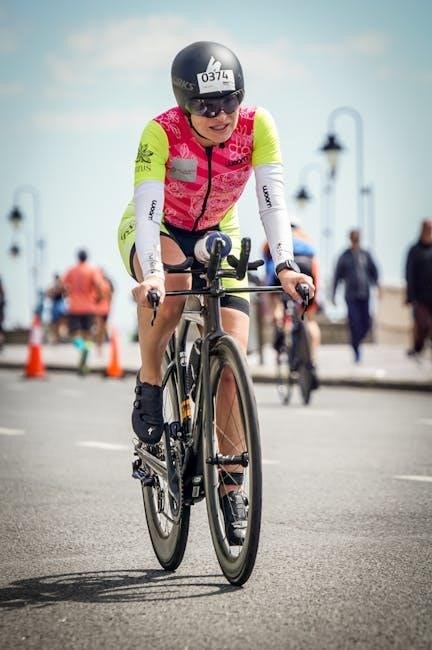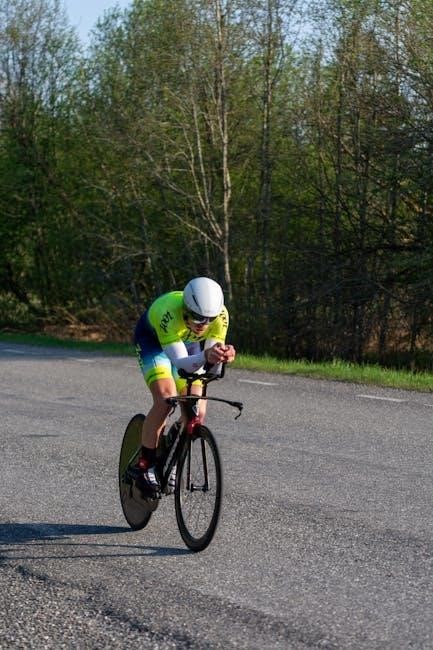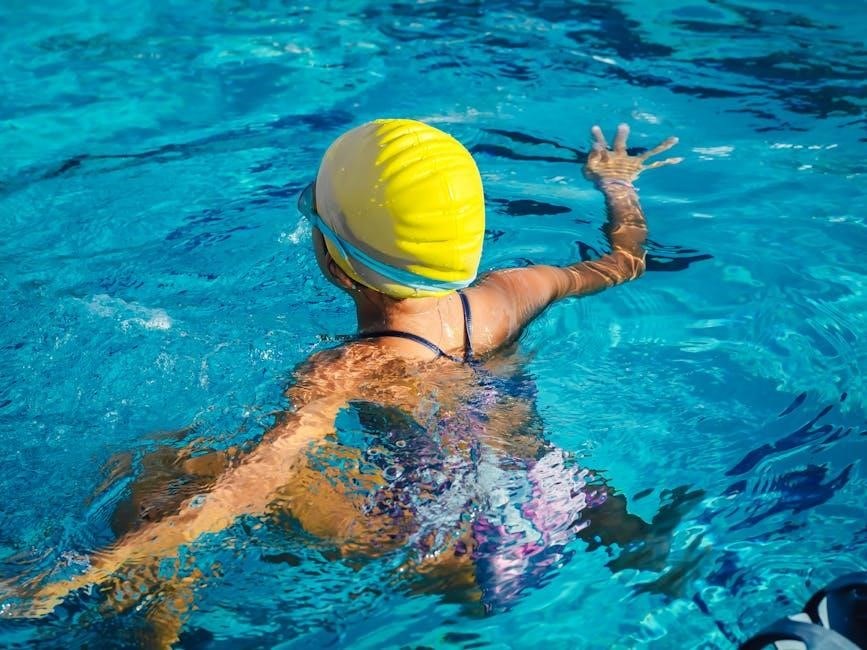Basics of Ironman Training Plan
An effective Ironman training plan must incorporate progressive overload and periodization․ It should gradually increase distance and intensity to build endurance, with a focus on consistency and recovery․
1․1 Variations in Training Plan
Ironman training plans vary based on athlete experience and goals․ A 24-week plan suits experienced triathletes, focusing on structured periodization․ A 20-week plan offers simplicity for those with limited time, emphasizing low volume․ Advanced athletes can opt for a 12-week plan, targeting peak fitness․ Each variation adjusts intensity, volume, and recovery to match the athlete’s level, ensuring progressive overload and race readiness․ These plans cater to different lifestyles and objectives, providing flexibility while maintaining foundational principles of endurance training․
1․2 Periodization and Progression
Periodization in Ironman training involves dividing the plan into phases, each with specific goals․ The base phase builds endurance, followed by a build phase that increases intensity․ Progression ensures gradual increases in swim, bike, and run distances, with rest periods to avoid injury․ This structured approach prevents plateaus and enhances performance, ensuring athletes reach peak fitness by race day․ Proper periodization balances workload and recovery, crucial for long-term success in endurance events like Ironman․

Plan Overview
A comprehensive 24-week Ironman training plan structured into base building and race preparation phases․ It includes detailed workouts, nutrition advice, recovery strategies, and tapering techniques for peak race performance․
2․1 Structure and Phases
The 24-week Ironman training plan is divided into distinct phases: base building, build, and race preparation․ Each phase focuses on progressive overload, increasing endurance, and specific race skills․ The base phase establishes foundational fitness, while the build phase intensifies workouts with race-pace efforts․ The final phase includes tapering to ensure peak performance on race day․ Weekly training hours escalate from 8 to 15-18, emphasizing consistency, recovery, and race-specific preparation․
2․2 Weekly Volume Progression
The Ironman training plan progresses weekly, starting with 8 hours of training and increasing to 15-18 hours․ Each week includes a rest day for recovery․ Swimming, cycling, and running volumes escalate gradually, with long workouts on weekends․ The plan ensures a balanced build of endurance, strength, and race-specific skills, avoiding injury through controlled progression․ This structured approach prepares athletes for the demands of a full-distance triathlon while allowing adaptation to increasing workloads․ Consistency and recovery are emphasized to maximize performance․

Nutrition and Recovery Guidelines
Nutrition is crucial for Ironman training․ Focus on a balanced diet rich in carbs, protein, and fats․ Practice race-day fueling during long workouts and prioritize recovery with a 3:1 carb-to-protein ratio post-session․
3․1 Training Nutrition
A well-structured training nutrition plan is essential for fueling workouts and aiding recovery․ Focus on a balanced diet rich in carbohydrates, protein, and healthy fats to sustain energy levels․ During long sessions, practice race-day nutrition by consuming gels, sports drinks, or snacks every 30-45 minutes․ Post-workout, prioritize recovery with a 3:1 ratio of carbohydrates to protein within 30-60 minutes․ Proper hydration and electrolyte balance are also critical to avoid dehydration and maintain performance․
3․2 Recovery Techniques
Effective recovery is crucial for maximizing training adaptations․ Incorporate techniques like foam rolling, stretching, and low-intensity aerobic activities to enhance blood flow and reduce muscle soreness․ Prioritize quality sleep, aiming for 7-9 hours nightly, to support physical and mental rejuvenation․ Additionally, consider modalities such as ice baths, compression garments, or massage therapy to aid muscle recovery․ Ensure one full rest day per week, avoiding any physical activity, to allow your body to repair and adapt to the demands of training․

24-Week Ironman Training Plan
A 24-week Ironman training plan provides a structured approach to building endurance․ It includes periodized phases focusing on base building, intensity, and race-specific workouts to achieve peak fitness․
4․1 Base Building Phase
The base building phase focuses on establishing a solid aerobic foundation through consistent training․ It emphasizes low-intensity workouts, gradual volume increases, and skill development across swimming, cycling, and running․ This phase is crucial for building endurance and injury prevention․ Athletes start with shorter sessions and progressively extend their swim, bike, and run distances․ Strength training and flexibility exercises are also integrated to enhance overall durability․ The goal is to create a sustainable fitness level before introducing higher-intensity efforts․
4․2 Build and Race Preparation
The build phase shifts focus to increasing intensity and race-specific workouts․ Athletes introduce brick sessions, simulating race-day transitions between disciplines․ Swim, bike, and run workouts become more structured, with tempo and threshold efforts to enhance speed and endurance․ Long-distance sessions are maintained but augmented with higher-intensity intervals․ Nutrition and pacing strategies are refined during this period․ Recovery remains critical as the body adapts to heightened demands, ensuring peak fitness aligns with race day․

20-Week Simplified Training Plan
This low-volume plan is ideal for athletes with limited time, starting at 8 hours/week and progressing to 15-18 hours․ It focuses on consistency and gradual endurance building․
5․1 Low-Volume Approach
This plan is designed for athletes with limited time, offering a structured yet simple approach․ It starts at 8 hours/week, progressing to 15-18 hours, focusing on swim, bike, and run consistency․ The low-volume design emphasizes quality over quantity, with one full rest day weekly to prevent burnout․ Workouts are tailored to build endurance gradually, ensuring adaptation․ While it doesn’t include training races, athletes are encouraged to participate in tune-up events for race simulation․ This approach balances training and recovery effectively, making it ideal for time-constrained triathletes․
5․2 Key Workouts and Rest Days
The plan emphasizes consistency with key workouts, including long swims, bike rides, and runs, to build endurance․ Brick sessions (bike-to-run) are crucial for race specificity․ Rest days are mandatory, with one full rest day weekly to ensure recovery․ While training races aren’t included, athletes are encouraged to participate in tune-up events for race simulation․ This structured approach balances intensity and recovery, making it suitable for time-constrained athletes aiming to complete an Ironman․ The focus is on quality and progressive overload to achieve peak race readiness․
Advanced 12-Week Training Plan
This 12-week plan is designed for advanced amateur triathletes aiming to achieve peak fitness for a full-distance Ironman triathlon in 12 weeks, assuming a solid base fitness level․
6․1 Peak Fitness Objectives
The advanced 12-week plan focuses on maximizing endurance, speed, and race readiness․ It targets experienced athletes aiming to enhance swim efficiency, bike strength, and running endurance․ Key objectives include building aerobic capacity, improving power output, and refining race-specific skills․ Workouts are structured to peak fitness just before the race, ensuring optimal performance․ The plan emphasizes nutrition, recovery, and mental preparation to achieve peak condition․ Athletes should already possess a strong base fitness level to handle the intensity and volume of this program effectively․
6․2 Race-Specific Workouts
Race-specific workouts are designed to simulate race day conditions, focusing on swim, bike, and run transitions․ Brick sessions (bike-to-run) and open-water swims are emphasized to build race readiness․ Swim workouts include long-distance sets, bike sessions focus on sustained power output, and runs incorporate race-pace intervals․ Nutrition and hydration strategies are practiced during long workouts to ensure optimal race-day execution․ These workouts aim to enhance endurance, speed, and mental toughness, preparing athletes for the demands of a full Ironman triathlon․

Creating a Personalized Training Plan
A personalized plan assesses fitness levels, sets realistic goals, and tailors workouts to fit individual schedules and preferences, ensuring a balanced approach to training and recovery․
7․1 Assessing Current Fitness Levels
Evaluating your current fitness levels is crucial for creating a personalized Ironman training plan․ Start by assessing your swim, bike, and run capabilities through time trials or benchmark workouts․ Measure your endurance, speed, and consistency․ Consider your weekly training volume, recovery capacity, and any physical limitations․ Use this data to set realistic goals and determine your starting point for progressive overload․ Tracking your baseline fitness ensures your plan is tailored to your needs, maximizing efficiency and minimizing injury risks․ Regular reassessment helps adjust the plan as you progress․
7․2 Tailoring Workouts to Lifestyle
Adapting your Ironman training plan to fit your lifestyle is essential for sustainability․ Consider your work schedule, family commitments, and personal preferences when structuring workouts․ Consider time constraints and prioritize consistency․ Early morning sessions or splitting workouts into smaller parts can help balance training with daily responsibilities․ Incorporate flexible scheduling to accommodate unexpected obligations․ The plan should align with your unique circumstances, ensuring adherence and reducing burnout․ This personalized approach fosters long-term commitment and maximizes progress toward your Ironman goals․

Tapering and Race Day Strategy
A well-structured taper reduces training to prevent overtraining, enhancing race-day performance․ Race strategy includes planning, pacing, and execution tailored to individual goals and demands․
8․1 Tapering Techniques
Tapering involves reducing training volume while maintaining intensity to ensure peak performance on race day․ Gradually decrease swim, bike, and run distances by 20-30% over 2-3 weeks․ Focus on active recovery, incorporating rest days and low-intensity sessions․ Prioritize proper nutrition and hydration to optimize energy stores․ Include race simulation workouts to refine pacing and strategy․ Ensure equipment is race-ready and mentally prepare for the event․ This balanced approach maximizes recovery and sharpens race-specific skills․
8․2 Race Day Execution
On race day, execute your plan with precision; Start with a nutritious breakfast and ensure all gear is race-ready․ Arrive early to set up transitions smoothly․ Begin the swim at a steady pace, focusing on efficiency․ On the bike, maintain consistent power output and hydrate regularly․ Transition efficiently to the run, starting at a manageable pace to avoid burnout․ Stay hydrated and fueled, drawing on mental resilience to push through challenges․ Cross the finish line with confidence, knowing your preparation has led you to this moment․
